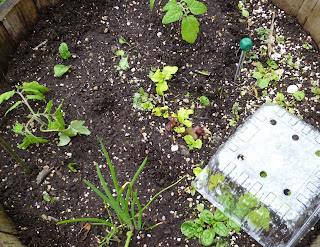Peaches are still blooming. I usually go out with a paintbrush and play the honeybee, pollinating the flowers. This year I'm not. There are usually way too many pollinated flowers, resulting in way too many fruits. Then they need to be thinned. Good peaches only happen if they are at least a hand width apart. That's a fat hand like mine. Maybe 6 inches.. That's for genetic dwarf peaches. If there is a lot of leaf curl, many if not all of the peaches are lost, and pollination was not worth the effort.

The trees are lovely. If they did not have peaches, they would be sold purely as ornamentals. That is, except here in the Maritime Pacific Northwest, where ornamentals that get leaf curl are not needed.

It lookes like the infestation could be small. It's on some leaves. Not all tips. Leave curl results in a very pretty appearance at this stage. The leaves have a maroon variegated edge and start to become curly. Evil is sometimes quite pretty. It usually gets worse as the leaves grow. Wait and see. Treatment now is not helpful. Maybe the midwinter copper spray was helpful. I try not to get my hopes up. It would be great if that method worked.



 They are a little more leggy than I like, but still OK. If too leggy I can just plant them deeper.
They are a little more leggy than I like, but still OK. If too leggy I can just plant them deeper. I wasn't going to set up the "wall-o-water" units but under the circumstances, I think they are the best approach. I took the soil temperature, it's 50 degrees, so technically warm enough to plant. I will leave these units in place for 2 days then plant tomato plants. There will be some extra plants to try elsewhere. The arrangement is not planned. My garden not only has an "organic" soil/pest management/compost/plant food philosophy, but apparently has an "organic" constantly evolving shape. Not planned that way, but it is what it is. Nonlinear, no straight edges or 90 degree corners.
I wasn't going to set up the "wall-o-water" units but under the circumstances, I think they are the best approach. I took the soil temperature, it's 50 degrees, so technically warm enough to plant. I will leave these units in place for 2 days then plant tomato plants. There will be some extra plants to try elsewhere. The arrangement is not planned. My garden not only has an "organic" soil/pest management/compost/plant food philosophy, but apparently has an "organic" constantly evolving shape. Not planned that way, but it is what it is. Nonlinear, no straight edges or 90 degree corners. I planted 3 tomato plants in this barrel, too. One has a plastic container cover. I'll look around and see if I can find more, otherwise I'll buy something at the grocery store today. I think it's still too cool to have them completely unexposed, at least at night. A cover would also result in warmer soil & roots.
I planted 3 tomato plants in this barrel, too. One has a plastic container cover. I'll look around and see if I can find more, otherwise I'll buy something at the grocery store today. I think it's still too cool to have them completely unexposed, at least at night. A cover would also result in warmer soil & roots.